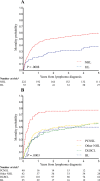Temporal trends in presentation and survival for HIV-associated lymphoma in the antiretroviral therapy era
- PMID: 23892362
- PMCID: PMC3748003
- DOI: 10.1093/jnci/djt158
Temporal trends in presentation and survival for HIV-associated lymphoma in the antiretroviral therapy era
Abstract
Background: Lymphoma is the leading cause of cancer-related death among HIV-infected patients in the antiretroviral therapy (ART) era.
Methods: We studied lymphoma patients in the Centers for AIDS Research Network of Integrated Clinical Systems from 1996 until 2010. We examined differences stratified by histology and diagnosis year. Mortality and predictors of death were analyzed using Kaplan-Meier curves and Cox proportional hazards.
Results: Of 23 050 HIV-infected individuals, 476 (2.1%) developed lymphoma (79 [16.6%] Hodgkin lymphoma [HL]; 201 [42.2%] diffuse large B-cell lymphoma [DLBCL]; 56 [11.8%] Burkitt lymphoma [BL]; 54 [11.3%] primary central nervous system lymphoma [PCNSL]; and 86 [18.1%] other non-Hodgkin lymphoma [NHL]). At diagnosis, HL patients had higher CD4 counts and lower HIV RNA than NHL patients. PCNSL patients had the lowest and BL patients had the highest CD4 counts among NHL categories. During the study period, CD4 count at lymphoma diagnosis progressively increased and HIV RNA decreased. Five-year survival was 61.6% for HL, 50.0% for BL, 44.1% for DLBCL, 43.3% for other NHL, and 22.8% for PCNSL. Mortality was associated with age (adjusted hazard ratio [AHR] = 1.28 per decade increase, 95% confidence interval [CI] = 1.06 to 1.54), lymphoma occurrence on ART (AHR = 2.21, 95% CI = 1.53 to 3.20), CD4 count (AHR = 0.81 per 100 cell/µL increase, 95% CI = 0.72 to 0.90), HIV RNA (AHR = 1.13 per log10copies/mL, 95% CI = 1.00 to 1.27), and histology but not earlier diagnosis year.
Conclusions: HIV-associated lymphoma is heterogeneous and changing, with less immunosuppression and greater HIV control at diagnosis. Stable survival and increased mortality for lymphoma occurring on ART call for greater biologic insights to improve outcomes.
Figures


Comment in
-
Implications of the shifting pathobiology of AIDS-related lymphoma.J Natl Cancer Inst. 2013 Aug 21;105(16):1170-1. doi: 10.1093/jnci/djt192. Epub 2013 Jul 26. J Natl Cancer Inst. 2013. PMID: 23892361 No abstract available.
References
-
- Patel P HD, Sullivan PS, Novak RM, et al. Incidence of types of cancer among HIV-infected persons compared with the general population in the United States, 1992–2003. Ann Intern Med. 2008;148(10):728–736 - PubMed
-
- Engels EA, Pfeiffer RM, Goedert JJ, et al. Trends in cancer risk among people with AIDS in the United States 1980–2002. AIDS. 2006;20(12): 1645–1654 - PubMed
-
- Grulich AE, van Leeuwen MT, Falster MO, Vajdic CM. Incidence of cancers in people with HIV/AIDS compared with immunosuppressed transplant recipients: a meta-analysis. Lancet. 2007;370(9581)59–67 - PubMed
-
- Bohlius J, Schmidlin K, Boué F, et al. HIV-1-related Hodgkin lymphoma in the era of combination antiretroviral therapy: incidence and evolution of CD4+ T-cell lymphocytes. Blood. 2011;117(23):6100–6108 - PubMed
Publication types
MeSH terms
Grants and funding
- K01 TW009488/TW/FIC NIH HHS/United States
- R25 TW009340/TW/FIC NIH HHS/United States
- R24 AI067039/AI/NIAID NIH HHS/United States
- P30 CA060553/CA/NCI NIH HHS/United States
- P30AI50410/AI/NIAID NIH HHS/United States
- P30 AI036219/AI/NIAID NIH HHS/United States
- 1R25TW009340-01/TW/FIC NIH HHS/United States
- 1K01TW009488-01/TW/FIC NIH HHS/United States
- T32 AI007140/AI/NIAID NIH HHS/United States
- P30 CA016086/CA/NCI NIH HHS/United States
- P30 AI027767/AI/NIAID NIH HHS/United States
- P30 AI36219/AI/NIAID NIH HHS/United States
- P30 AI027763/AI/NIAID NIH HHS/United States
- U01 AI069918/AI/NIAID NIH HHS/United States
- P30 AI050410/AI/NIAID NIH HHS/United States
- R21 CA180815/CA/NCI NIH HHS/United States
LinkOut - more resources
Full Text Sources
Other Literature Sources
Medical
Research Materials
Miscellaneous

